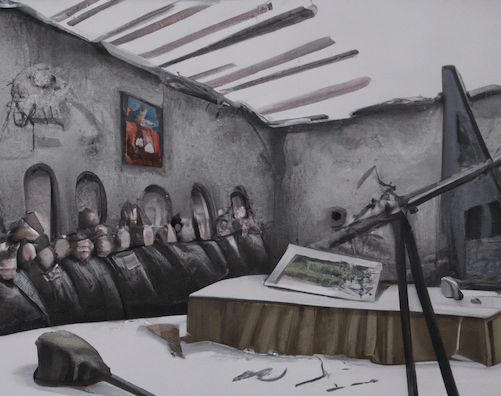
Project Paperclip was a top-secret operation carried out by the United States government immediately after World War II. Its purpose was to recruit prominent German scientists and engineers from Nazi Germany to work for the US in the fields of rocketry, medicine, and other technologies. The operation was carried out in strict secrecy, with the true nature of the program hidden from the public for several decades.
At the end of the war, the US was facing intense competition from the Soviet Union in the race to claim Nazi technological advancements and intellectual property. The US government was determined to gain an edge in this race, and Project Paperclip provided a means to do so. The program aimed to bring over some of the brightest minds from Nazi Germany, including scientists and engineers who had played key roles in developing the V-2 rocket and other advanced technologies.
The operation was carried out with the utmost discretion, with the US government going to great lengths to conceal the true identities and backgrounds of the scientists being recruited. Many of the scientists had been members of the Nazi Party or had close ties to the Nazi regime, and the US government was eager to keep these associations hidden from the public.
Despite the efforts of the US government to keep the operation secret, the truth about Project Paperclip eventually came to light. In the 1970s, the truth about the program was revealed through a series of articles in the press and government documents that were made public. The exposure of the program led to widespread public outrage, with many people viewing it as a betrayal of American values and an endorsement of Nazi ideology.
Despite the controversy surrounding Project Paperclip, it is widely acknowledged that the program played a critical role in the development of modern technology. Many of the scientists who were brought over to the US as part of the operation went on to make major contributions to the fields of rocketry, medicine, and other technologies, helping to advance US scientific and technological capabilities.
In conclusion, Project Paperclip was a top-secret operation carried out by the US government after World War II, with the goal of recruiting prominent German scientists and engineers to work for the US. The operation was controversial, with many people viewing it as a betrayal of American values and an endorsement of Nazi ideology. However, it is widely acknowledged that the program played a critical role in the development of modern technology, with many of the scientists who were recruited making major contributions to various fields.
During Project Paperclip, the US government recruited a number of prominent German scientists and engineers who had worked on advanced technologies during the Nazi regime. Some of the most well-known scientists recruited as part of the program include:
- Wernher von Braun: A leading figure in the development of the V-2 rocket, von Braun was a key figure in Project Paperclip. He later went on to play a key role in the development of the US space program and was one of the main architects of the Apollo program that sent astronauts to the moon.
- Arthur Rudolph: A rocket engineer who worked on the V-2 program, Rudolph was one of the key figures in Project Paperclip. He later worked for NASA and was instrumental in the development of the Saturn V rocket that powered the Apollo missions.
- Hubertus Strughold: A physician who conducted experiments on concentration camp prisoners during the war, Strughold was one of the most controversial figures recruited as part of Project Paperclip. Despite his association with Nazi war crimes, he was brought to the US as part of the program and went on to make important contributions to the field of space medicine.
- Kurt Debus: A rocket engineer who worked on the V-2 program, Debus was one of the key figures in Project Paperclip. He later became the first director of NASA’s Kennedy Space Center and played a key role in the development of the US space program.
- Walter Dornberger: A high-ranking military official who oversaw the V-2 program, Dornberger was one of the key figures in Project Paperclip. He later worked for Bell Aircraft and was instrumental in the development of the US ballistic missile program.
Many of the scientists who were recruited as part of Project Paperclip were members of the Nazi party and worked on projects for the regime during World War II, including rocket and chemical weapons research. Some of these scientists were involved in war crimes and human rights violations, but many were able to continue their careers in the US without facing consequences for their actions during the war.
Books Based on Project Paperclip
Project Paperclip was a secret United States intelligence operation that brought over 1,600 German scientists, engineers, and technicians to the United States after World War II. These scientists were often former members of the Nazi Party and had been involved in the development of advanced technologies such as rocketry, aircraft, and chemical weapons. Their expertise was highly sought after by the United States government and military, as well as private industry.
This operation has inspired a number of works of fiction over the years, including novels and short stories. Here are five books based on Project Paperclip:
- Operation Paperclip by Annie Jacobsen – This non-fiction book provides an in-depth look at the history of Project Paperclip and its aftermath, including the impact it had on American science and technology.
- The Good German by Joseph Kanon – Set in post-war Berlin, this novel follows an American journalist who becomes embroiled in a murder mystery that involves former Nazis and members of Project Paperclip.
- The Rocketeer by Dave Stevens – This graphic novel series, set in the 1930s and 1940s, follows a stunt pilot who discovers a rocket pack that was designed by a Nazi scientist brought to the United States under Project Paperclip.
- The Winter Fortress by Neal Bascomb – This non-fiction book tells the true story of a group of Norwegian commandos who were sent on a mission to destroy a Nazi heavy water plant that was being overseen by a German scientist who had been brought to the United States under Project Paperclip.
- The 5th Wave by Rick Yancey – While not directly focused on Project Paperclip, this young adult novel features an alien invasion that has been aided by a group of human collaborators who were recruited after World War II, including former Nazis brought to the United States under Project Paperclip.
These books provide unique and thought-provoking perspectives on Project Paperclip and the impact it had on the post-war world. They explore the moral and ethical implications of bringing former Nazis to the United States and the ways in which their knowledge and expertise were used for both good and evil.
Keywords: Project Paperclip, Nazi Germany, US government, V-2 rocket, technology, secret operation, controversy, scientific advancements.
Check out our Novel Writing Workbooks
Check out Little Tree Food Forest for articles on food forests and homesteading.
Check out FoodieScapes for articles on growing, fermenting and preserving food.










